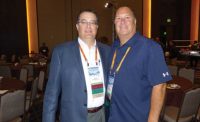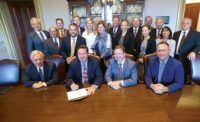ASA member contingent meets with White House officials to discuss plumbing industry
Getting down to business at the American Supply Association.

The American Supply Association spearheaded a select group of plumbing representatives who participated in a meeting inside the White House where numerous industry hot-button topics were discussed. Photo courtesy of ASA

The plumbing industry delegation educated White House officials about the ongoing labor crisis in the trades and the dire need to expand and update apprenticeship programs, particularly at the high-school level.


In recent years, the American Supply Association has increased its advocacy pillar not only at its members’ local and state government levels, but at the national level in Washington, D.C., as well.
In September, ASA took things to an entirely new level when it spearheaded a select group of plumbing representatives who participated in a meeting inside the White House, discussing the importance of such industry hot-button issues as tax reform, infrastructure needs and of the most urgent importance workforce development as the labor shortage throughout the PHCP-PVF supply chain continues to broaden.
The meeting was a joint collaboration facilitated by ASA and Plumbing Heating Cooling Contractors — National Association.
In addition to ASA CEO Mike Adelizzi and ASA Director of Government Affairs Dan Hilton, PHCP-PVF executives Rick Schwartz (Winsupply), Tim Jahnke (Elkay), Tim Ferry (InSinkErator/Emerson Commercial and Residential Solutions), Steve DeLarge (American Standard Brands/LIXIL Water Technology Americas), Carl Pinto (Bradford White) and Steve Cook (Northeastern Supply) participated in the meeting along with PHCC executives.
In attendance from the White House were George Sifakis (Office of Public Liaison, assistant to the president); Steve Munisteri (Office of Public Liaison, deputy assistant to the president), DJ Gribbin (National Economic Council, special assistant to the president for economic policy), Kara McKee (Domestic Policy Council, Education, Woman & Families & Workforce Policy), Paul Ray (Department of Labor, counselor to the Secretary of Labor) and Dianne Quebral (Office of Public Liaison, business liaison).
“I think it was a successful conversation in that we were able to have a dialogue with critical/influential individuals on some key issues facing our industry and country,” said Jahnke, Elkay’s CEO. “Having interactions with people who have an impact on tax, the infrastructure bill, the Department of Labor and details of the already stated goals with employee training and apprenticeships was critical to position us as an ‘informational source’ for the administration. This allows us to help guide what happens and to have the most impact on creating the best possible end solutions for the industry.”
Zeroing in on the workforce
PHCP-PVF executives in attendance were quick to focus on the workforce-development portion of the gathering.
The ASA-PHCC contingent presented a compelling statistical case as to where the supply chain stands when it comes to the current workforce and what it will look like in future years. According to a study by ASA, roughly 200,000 people currently are employed in the manufacturing and distribution segments of the PHCP-PVF industry. ASA also notes DOL’s Bureau of Labor Statistics estimates 400,000 installers are currently employed, making the plumbing industry a significant source of high-paying professional jobs.
But ASA’s 2015 study shows the industry will lose 25% of its current labor force in the next eight years and nearly half by 2035. ASA adds that with less than 4% of the industry’s current workforce under the age of 26, a labor shortage is impacting the nation and consumers. Additionally, ASA notes authoritative studies predict the labor shortage will escalate construction prices and hinder the availability of dependable services to Americans who need system repairs and renovations.
“It was critical for organizations and businesses to have a voice in the White House to address the topic of workforce development for the PHCP/PVF industry,” said Pinto, Bradford White’s director of marketing. “For those outside the industry, they typically do not have an appreciation for the broader implications of the deepening workforce shortage we face. That said, we were pleased to see that the Trump administration seemed fairly well-tuned into this challenge and had a good understanding of some of the root causes behind the general lack of knowledge regarding the importance of the trades and the dwindling interest in trade careers.”
In response to the critical need to attract new workers into the PHCP-PVF industry, the ASA-PHCC contingent offered a number of solutions, including jump-starting training by providing applied technology training in high schools, enabling students to leave high-school as second- or third-year apprentices, as well as supporting states establishing accredited plumbing programs in high schools across the country.
The group also urged White House officials to include construction issues in the DOL Task Group on Apprenticeship Training — a taskforce to be named in the near future.
“InSinkErator and Emerson representatives were very proud to accompany PHCC and our industry partners to the White House where we could bring attention to the need to recruit and retain our next generation of skilled tradespeople,” said Ferry, Emerson Commercial & Residential Solutions’ group president. “This need is urgent and requires a focused effort from all in positions of leadership to attract young people to the plumbing industry, which not only provides for our daily comfort and hygiene, but also is vitally important to the U.S. economy.”
Schwartz, Winsupply’s chairman, applauded President Trump’s “Expanding Apprenticeships in America” executive order he issued in June. Trump’s executive order focused on the elimination of a lot of federal restrictions that have prevented industries from creating apprenticeship programs,” he said.
Schwartz explained why a solution at the federal level will be impactful. “The problem is a lot of people have a poor perception of the skilled and technical trades,” he said. “Colleges and universities with their bigger budgets have made young people believe they can’t be successful or make a lot of money in life without a four-year degree. Trade groups don’t have the budgets to do that kind of marketing so it’s hard for them to convince young people that being in this industry is a great career and they can make a lot of money.”
Pinto shares Schwartz’s sentiments. “This is simply not about a change in educational approaches and the availability of trade training,” he stressed. “There is a major cultural component to this challenge that must be addressed in the minds of Americans. For the past several decades, the trades and related careers such as manufacturing have been relegated to a ‘Plan B’ option while college has been touted as the only viable path to a rewarding career with good pay. Until America begins to embrace the trades again as an excellent path to success as another ‘Plan A,’ the workforce-development and growth challenges for the trades will continue.”
Schwartz, like others who were part of the industry delegation, agrees the sooner a solution is found the better. “It’s essential to resolve the labor shortage or we’re never going to grow the economy at a faster pace,” he said. “The labor shortage is impacting everyone. Construction projects are slow to get going and the lack of skilled labor has contributed to slow
economic growth.”
Cook, Northeastern’s CEO who will be ASA’s president in 2019, felt legitimate progress was made during the White House meeting. “We had high-level people listening to us,” he said. “It was encouraging to me to talk to people who really get it. It was refreshing to see and it was a day well-spent. It was an open and honest discussion. We have to continue to do something to better-prepare young people to go into the industry and streamline the process. I left there thinking, ‘We might get something done here.’”
Next month: Supply House Times Chief Editor Mike Miazga’s talks with ASA’s Adelizzi about the White House meeting and ASA’s continued push forward on the workforce development front.
This article was originally titled “Getting down to business” in the November 2017 print edition of Supply House Times.
Looking for a reprint of this article?
From high-res PDFs to custom plaques, order your copy today!








